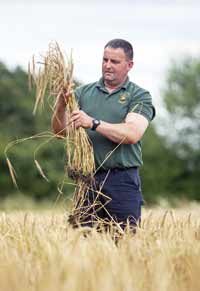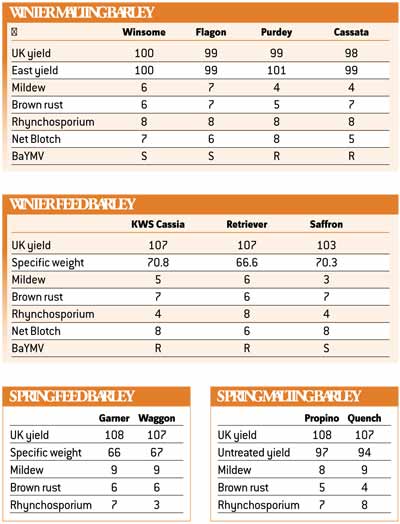RL 2010: Small yield improvements in barley sector

It’s small steps in both barley markets. Two new malting and one feed variety have been recommended for winter barley, while one malt variety for brewing and a two-row feed have made it onto the spring list.
Both potential winter malting types are from Syngenta Seeds. Winsome has been given a full UK recommendation, with a UK treated yield 1% above Flagon. Neither variety has barley yellow mosaic virus resistance.
Winsome had very good malting potential, HGCA‘s Jim McVittie said. “The maltsters seem quite excited about it.”
But it was early days, he stressed. “You can’t do malting tests until dormancy has broken, which will be after Christmas. It is then considered for provisional Institute of Brewing and Distilling (IBD) approval in June 2010, and a year after that for full approval.
“It is not unusual for a variety to fail at a later stage, so make sure you talk to your merchant before growing it, even after any provisional approval,” he warned.
Winsome’s straw strength is rated a six compared with Flagon’s five, which Dr McVittie suggested was one of Flagon’s weak points. All round disease resistance is good, with an eight for rhynchosporium and seven for net blotch (see table 1).
The second potential malter, Purdey, has been given a double specific recommendation. It is 1% higher yielding than fellow BaYMV-resistant Cassata, while it is also the highest yielding variety overall in the east at 101%, putting it 1% above Winsome and 2% above Flagon and Cassata.
“It has good malting potential equivalent to Cassata, albeit with the same caveats about IBD approval.”
Purdey’s wet weather disease resistance was good, Dr McVittie said, but it was weaker against mildew. “It is more susceptible than Pearl, which is typically the one we see mildew on.”
Winsome had the highest hot water extract on the Recommended List, three litres above Flagon, while Purdey was three litres higher than Cassata, Dr McVittie added.
That should help end users, Robert Hiles of Syngenta Seeds said. “If end users are looking to limit the number of varieties they use, it is a simple choice to select those with the highest hot water extract to improve production efficiency.”
Purdey also produced a high diastatic power in malting tests, he said. “This could make it suited to the Scottish distilling market for use in alcohol blends.”
Propino is the latest addition to a long line of Syngenta Seeds success in spring malting barley. “It is Quench with a bit more yield,” Dr McVittie said. One percent to be exact, according to the figures (see Table 2).
Its potential was for producing brewing malt, so it would appeal more to English growers, he suggested. “It has good resistance to lodging and brackling; brown rust is its weakest disease.”
Feed barley growers have one new choice in both winter and spring sectors. The winter variety, two-row KWS Cassia had the yield of Retriever, with the specific weight of Saffron, Dr McVittie said.
“Many growers have been put off growing Retriever by its low specific weight,” he pointed out. “This does have a couple of weaknesses – mildew and rhynchosporium.”
Rhynchosporium is rated as a four, the same as Saffron, while mildew is a five, better than Saffron’s three. Unlike Saffron it is also BaYMV resistant.
The new spring feed is Garner from Syngenta Seeds. It beats Waggon by 1% to become the top yielding spring feed on the RL. “Untreated yields are good, at 97% compared with 92% for Waggon.”
Higher rhynchosporium resistance appears to be the main reason; it is rated as a seven compared with Waggon’s three.


